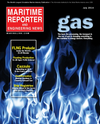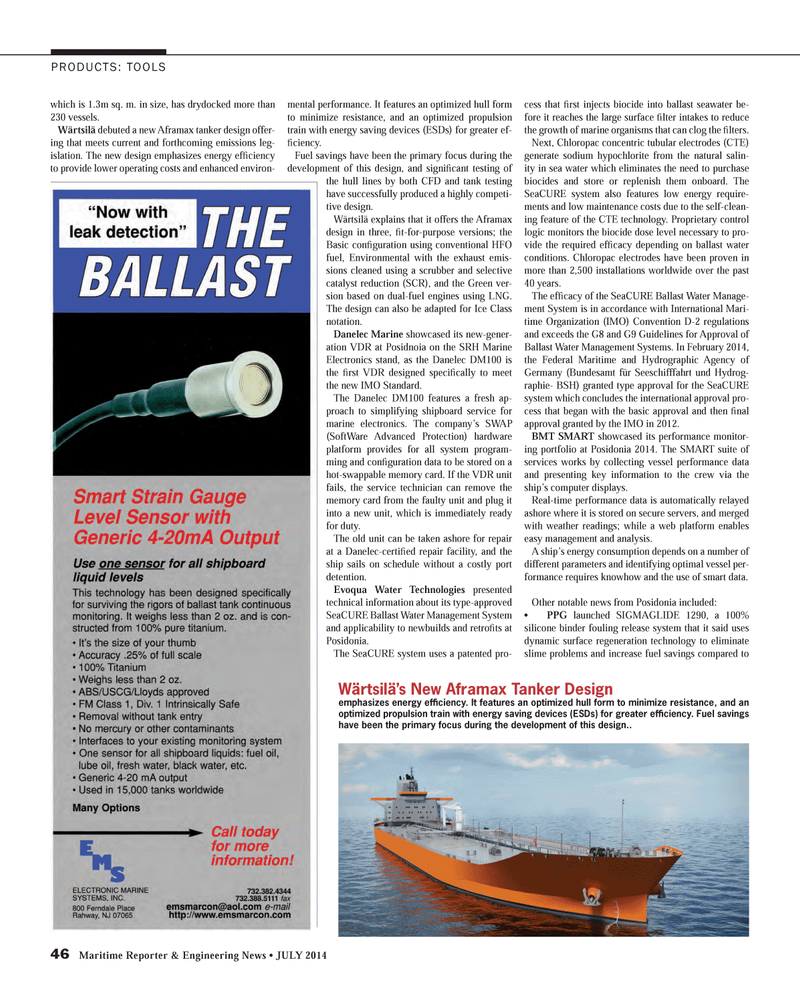
Page 46: of Maritime Reporter Magazine (July 2014)
Offshore Energy Structures & Systems
Read this page in Pdf, Flash or Html5 edition of July 2014 Maritime Reporter Magazine
46 Maritime Reporter & Engineering News • JULY 2014 which is 1.3m sq. m. in size, has drydocked more than 230 vessels.
Wärtsilä debuted a new Aframax tanker design offer- ing that meets current and forthcoming emissions leg- islation. The new design emphasizes energy effi ciency to provide lower operating costs and enhanced environ- mental performance. It features an optimized hull form to minimize resistance, and an optimized propulsion train with energy saving devices (ESDs) for greater ef- fi ciency.
Fuel savings have been the primary focus during the development of this design, and signifi cant testing of the hull lines by both CFD and tank testing have successfully produced a highly competi- tive design.
Wärtsilä explains that it offers the Aframax design in three, fi t-for-purpose versions; the
Basic confi guration using conventional HFO fuel, Environmental with the exhaust emis- sions cleaned using a scrubber and selective catalyst reduction (SCR), and the Green ver- sion based on dual-fuel engines using LNG.
The design can also be adapted for Ice Class notation.
Danelec Marine showcased its new-gener- ation VDR at Posidnoia on the SRH Marine
Electronics stand, as the Danelec DM100 is the fi rst VDR designed specifi cally to meet the new IMO Standard.
The Danelec DM100 features a fresh ap- proach to simplifying shipboard service for marine electronics. The company’s SWAP (SoftWare Advanced Protection) hardware platform provides for all system program- ming and confi guration data to be stored on a hot-swappable memory card. If the VDR unit fails, the service technician can remove the memory card from the faulty unit and plug it into a new unit, which is immediately ready for duty.
The old unit can be taken ashore for repair at a Danelec-certifi ed repair facility, and the ship sails on schedule without a costly port detention.
Evoqua Water Technologies presented technical information about its type-approved
SeaCURE Ballast Water Management System and applicability to newbuilds and retrofi ts at
Posidonia.
The SeaCURE system uses a patented pro- cess that fi rst injects biocide into ballast seawater be- fore it reaches the large surface fi lter intakes to reduce the growth of marine organisms that can clog the fi lters.
Next, Chloropac concentric tubular electrodes (CTE) generate sodium hypochlorite from the natural salin- ity in sea water which eliminates the need to purchase biocides and store or replenish them onboard. The
SeaCURE system also features low energy require- ments and low maintenance costs due to the self-clean- ing feature of the CTE technology. Proprietary control logic monitors the biocide dose level necessary to pro- vide the required effi cacy depending on ballast water conditions. Chloropac electrodes have been proven in more than 2,500 installations worldwide over the past 40 years.
The effi cacy of the SeaCURE Ballast Water Manage- ment System is in accordance with International Mari- time Organization (IMO) Convention D-2 regulations and exceeds the G8 and G9 Guidelines for Approval of
Ballast Water Management Systems. In February 2014, the Federal Maritime and Hydrographic Agency of
Germany (Bundesamt für Seeschifffahrt und Hydrog- raphie- BSH) granted type approval for the SeaCURE system which concludes the international approval pro- cess that began with the basic approval and then fi nal approval granted by the IMO in 2012.
BMT SMART showcased its performance monitor- ing portfolio at Posidonia 2014. The SMART suite of services works by collecting vessel performance data and presenting key information to the crew via the ship’s computer displays.
Real-time performance data is automatically relayed ashore where it is stored on secure servers, and merged with weather readings; while a web platform enables easy management and analysis.
A ship’s energy consumption depends on a number of different parameters and identifying optimal vessel per- formance requires knowhow and the use of smart data.
Other notable news from Posidonia included: • PPG launched SIGMAGLIDE 1290, a 100% silicone binder fouling release system that it said uses dynamic surface regeneration technology to eliminate slime problems and increase fuel savings compared to
PRODUCTS: TOOLS
Wärtsilä’s New Aframax Tanker Design emphasizes energy effi ciency. It features an optimized hull form to minimize resistance, and an optimized propulsion train with energy saving devices (ESDs) for greater effi ciency. Fuel savings have been the primary focus during the development of this design..
MR #7 (42-49).indd 46 7/1/2014 11:02:57 AM

 45
45

 47
47
